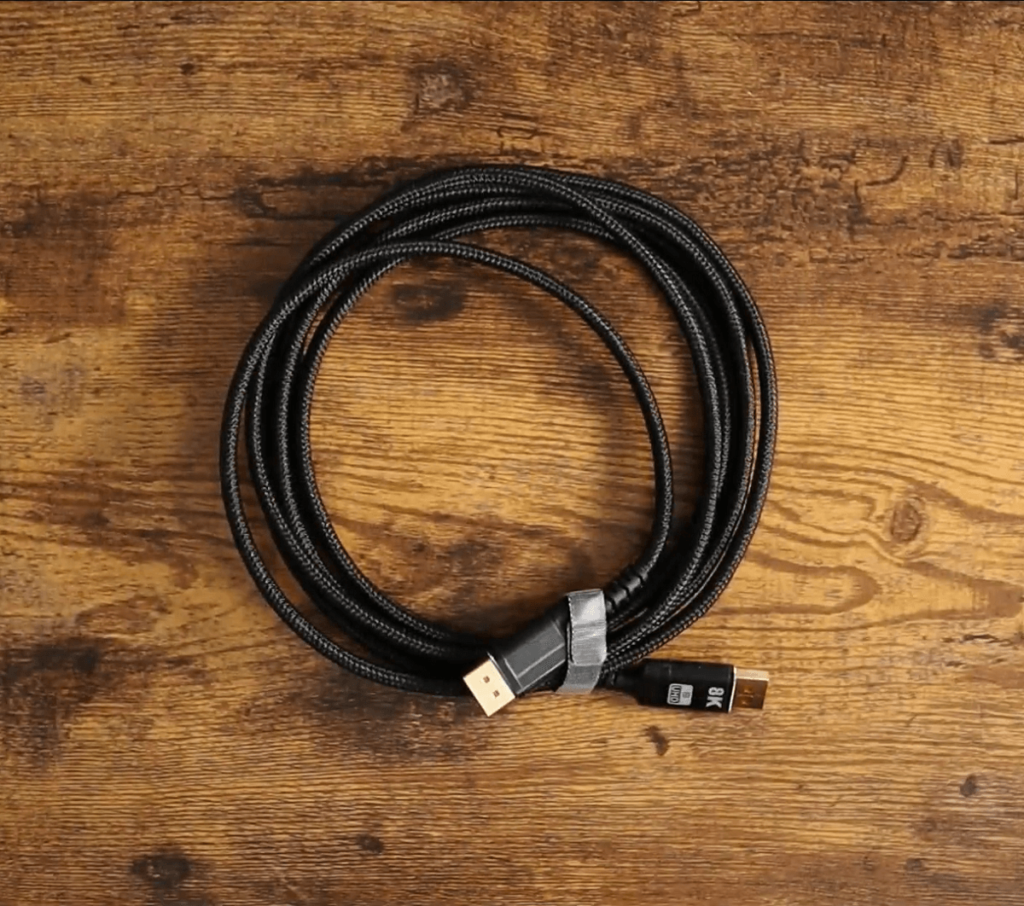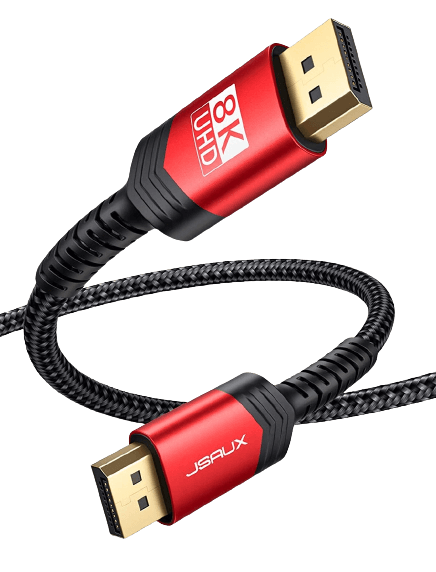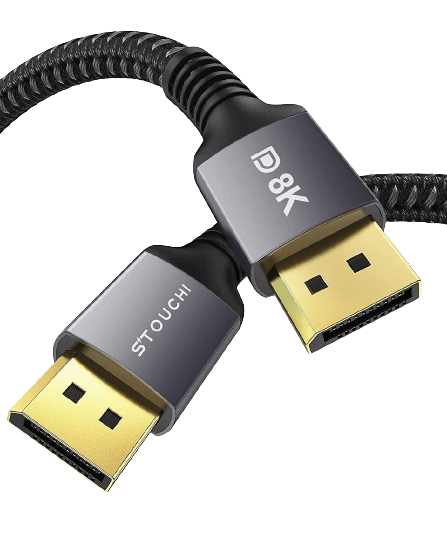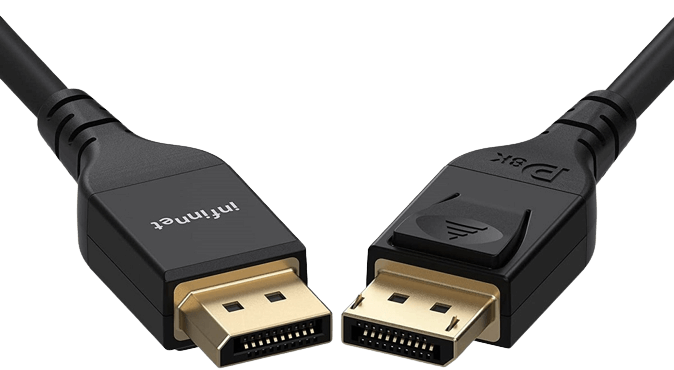Table of Contents
DisplayPort cable allows you to use a single cable to send both audio and video signals from a source device like a PC or laptop to a display or monitor. They’re comparable to HDMI cables. However, they currently only work between computers and monitors, so you can’t use them with gaming systems.
The best DisplayPort cables for 240 Hz refresh rates in 2023 are all DisplayPort 1.4 cables. They work well for professionals, individuals, and gamers who need to transfer visual and audio data from their computer to a single or multiple monitors.
Best DisplayPort Cable for Gaming
While DisplayPort 2.0 cables have been out since 2019, they’re still not as easy to find in 2002. Thus, DisplayPort 1.4 remains the most popular version and maintains the highest ratings in the market.
Plus, many computer display devices haven’t yet caught up to the technology of DisplayPort 2.0. Thus, the best DisplayPort cables for 240 Hz for 2022 are all DisplayPort 1.4 cables.
iVANKY VESA Certified DisplayPort Cable 1.4

The iVANKY VESA Certified DisplayPort Cable 1.4 supports 1080P at 240 Hz, 4K at 144 Hz, 5K at 60 Hz, and 8K at 60 Hz. It also supports Dynamic HDR and HDCP 2.2 and works with FreeSync and G-Sync.
iVANKY uses higher quality material for their DisplayPort than some other manufacturers, making the cable more dependable. 30AWG tinned copper cable with triple shielding ensures a stable signal transmission with 32.4 Gbps of bandwidth. Thick, nylon braiding around the cables and high-quality 24K gold-plated connectors help dissipate heat and extend cable life.
The cable works like a dream as long as the GPU settings are correct. Select “no scaling” to stop flashing problems. It’s important to know that the 20 pin is not active on this cable, which means it wont work with GPUs older than 2017.
The cable comes in 3.3-feet, 6.6-feet, 10-feet, and 15-feet options.
Pros
- Mirror, extended, and multi-screen splicing modes
- High-quality, sturdy cable materials
- Changes in resolution are fast
Cons
- Cable sometimes comes loose from the port
- 1080P resolution required to achieve a 240Hz refresh rate
- Is dangerous for GPUs older than 2017
JSAUX VESA Certified 8K DisplayPort Cable 1.4

The JSAUX VESA Certified 8K DisplayPort Cable 1.4 supports 2K at 165Hz; 4K at 144Hz, 240Hz, and 60 Hz; 5K at 60Hz; and 8K at 60Hz. Thus, it’s a great option for higher-resolution, high-refresh-rate gaming.
This ultra-durable cable has an aluminum shell, nylon-braided cover, and gold-plated connectors. The cable design also includes tinned copper and a triple-layer shielding for less interference. So, you won’t experience video or audio glitches, ghosting, or video/audio syncing issues.
It sometimes stops working with NVIDIA with multiple monitors, but it’s easily repairable by rechecking box in the control panel.
Choose from red or gray and six-foot or ten-foot versions. Choosing a red cable makes it more easily identifiable among your other black cables.
Pros
- Backwards compatible with previous DisplayPort versions
- 4K resolution possible with 240Hz refresh rate
- Works better than the cable that comes with Odyssey G7 and G9 monitors
Cons
- More thick and rigid, so it’s difficult to bend to get into a recessed port
Stouchi DisplayPort Cable 1.4

The Stouchi DisplayPort Cable 1.4 supports 2K at 120 Hz, 65Hz, and 240 Hz; 4K at 120Hz, 144 Hz, and 60Hz; 5K at 60Hz, and 8K at 60Hz.
The 30 AWG tinned copper wire in the cable eliminates flickering, providing a high-definition visual experience fast enough for gaming without interruption. Audio passes through flawlessly and uncompressed. Stouchi also tests their ultra-durable braided cable to withstand over 30,000 bends.
Digital noise is generally solvable by reducing the refresh rate or changing it out of HDR mode.
The gray cable comes in 4-foot, 6.6-foot, and 10-foot options with one or two cables per package.
Pros
- Offers mirror mode, extended mode, gaming mode, and multi-screen splicing mode
- Backwards compatible with previous versions
- Supports Display Stream Compression, Forward Error Correction, and HDR meta transport
Cons
- Sometimes struggles at higher refresh rates
- Not as bendable as some other cables
Infinnet DisplayPort Cable 1.4

The infinnet DisplayPort Cable 1.4 costs about twice as much as other DisplayPort 1.4 cables. However, it also provides higher refresh rates up to 390 Hz for a screaming-fast gaming gaming experience. The infinnet supports 1080P at 390Hz and 360 Hz, 2K at 280 Hz and 240 Hz, and 4K at 160 and 144 Hz.
The infinnet cable provides fast initialization, keeps a steady refresh rate, has a clear and stable image, and never drops frames. Its dependable and consistent high quality performance provides a significant difference in visual quality and makes gaming a pleasure. However, the thinner cable may not last as long as some cheaper, more-reinforced cables.
The cable may default to 59.9 Hz. However, resetting system settings allows it to support higher refresh rates.
Choose from a one-pack or two-pack version that’s 6 feet or 9 feet long. It also comes in a 6-foot mini DisplayPort version for smaller devices or Apple devices.
Pros
- Provides refresh rates up to 390Hz
- Backwards compatible with previous DisplayPort versions
- Comes in a mini version
Cons
- Costs about twice as much as other DisplayPort cables
- Thin cable without the strengthening layers others have
DisplayPort Types
There are two main types of DisplayPort cables:
- Standard DisplayPort cable: Most common
- Mini DisplayPort cable: Smaller cables, ideal for smaller devices, compatible with Apple devices, widely used with Thunderbolt technology
However, DisplayPort has released seven different versions of DisplayPort cables:
- DisplayPort 1.0 (2006): typical resolution of 1440p @ 60 Hz
- DisplayPort 2.0 (2007): typical resolution of 1440p @ 60 Hz
- DisplayPort 1.2 (2009): typical resolution of 4k @ 60 Hz
- DisplayPort 1.3 (2014): typical resolution of 4K @ 120 Hz, 8K @ 60 Hz (with DSC)
- DisplayPort 1.4 (2016): typical resolution of 4K @ 120 Hz, 8K @ 60 Hz (with DSC)
- DisplayPort 1.4a (2018): typical resolution of 4K @ 120 Hz, 8K @ 60 Hz (with DSC)
- DisplayPort 2.0 (2019): typical resolution of 8K @ 60 Hz
Lowest and Highest Specifications the DisplayPort Cable Supports
DisplayPort cables handle a wide range of resolution and refresh rates:
- Resolution: 2K (25060 x 1440) to 16K (15360 x 8640)
- Refresh rate: 60 Hz to 240 Hz
However, accomplishing a 240 Hz refresh rate requires a smaller, 4K resolution. Meanwhile, having the largest 16K resolution leaves you at a 60 Hz refresh rate.
Uses of DisplayPort Cable
Common uses for DisplayPort cables include:
- Professional business displays: DisplayPort cables originally were most popular for business-related, professional-grade laptops and desktops.
- High-end graphics cards and high-resolution monitors: DisplayPort cables are common on high-quality devices with high-end graphics cards or high-resolution monitors. They support high resolutions and high refresh rates.
- Multiple monitors: One common use of DisplayPort cables is for multiple desktop monitors. Having multiple monitors can increase productivity, while having a single cable to transfer both video and audio to each monitor is more convenient.
- PC gaming: Another common use of DisplayPort cables is for PC gaming because higher refresh rates provide a better and faster graphics experience.
- Freeing up HDMI ports: Additionally, using a DisplayPort cable can free up your HDMI ports if you want to connect a game console or other device.
How 240 Hz Helps With Gaming
A DisplayPort cable allows gamers to experience the full capabilities of advanced graphics. While it’s possible to use an HDMI connection, DisplayPort cables tend to be a better option because they support a wider range of resolutions and refresh rates.
For the purpose of gaming, monitors with 240hz refresh rates give you
- Smoother, less choppy animations
- Easier target tracking
- Reduced ghosting
- Reduced tearing
- Minimized distracting effects
- Less lag time
FAQ
Here are common questions that people ask about DisplayPort cables.
What’s max distance a DisplayPort cable can handle?
The maximum length of a DisplayPort cable is 49 feet. However, most come in sizes up to 15 feet. DisplayPort extension cables beyond 30 feet can cause a decrease in signal quality for some resolutions.
Is DisplayPort better than HDMI?
Whether a DisplayPort cable is better than HDMI depends on your needs. DisplayPort cables can support a higher bandwidth than HDMI cables. Meanwhile, HDMI 2.1 can support a wider range of resolutions and is compatible with more devices beyond monitors and computers.
What’s the speed of transfer on a DisplayPort cable?
DisplayPort 2.0 has the highest transfer speed of 77.36 Gbps. However, the data transfer speed for DisplayPort depends on the version of the cable that you have, with:
- DisplayPort 1.0: 5.18/8.65 Gbps
- DisplayPort 1.1: 8.64 Gbps
- DisplayPort 1.2: 17.28 Gbps
- DisplayPort 13: 25.92 Gbps
- DisplayPort 1.4: 25.92 Gbps
- DisplayPort 14.a: 25.92 Gbps
- DisplayPort 2.0: 80 Gbps
What is the highest resolution for DisplayPort?
DisplayPort 2.0 produces the highest resolution: 16K at 60 Hz with DSC (15360 x 8640 pixels).
What is the max refresh rate for DisplayPort?
The highest refresh rate for most DisplayPort cables is 240Hz. However, the infinnit DisplayPort cable has maximum refresh rates up to 390Hz.
Do all DisplayPort cables support 240Hz?
All DisplayPort cables are capable of supporting 240Hz.
What cable supports 1440p 240Hz?
DisplayPort 1.2, DisplayPort 1.3, DisplayPort 1.4, DisplayPort 1.4a, and DisplayPort 2.0 cables all support 1440p at 240Hz.
Final Thoughts on DisplayPort Cables for 240hz
DisplayPort cables tend to provide a better, clearer, more dependable image experience than some of the cables that come with some monitors. So, they can solve many glitching, ghosting, and syncing issues.
All DisplayPort cables can support 240Hz refresh rates (and some support even higher refresh rates). However, keep in mind that a higher refresh rate comes with a decreased resolution between 1080P and 4K.
In 2023, the best DisplayPort cables are still the 1.4 versions, but 2.0s are right around the corner as the technology becomes more readily available.

